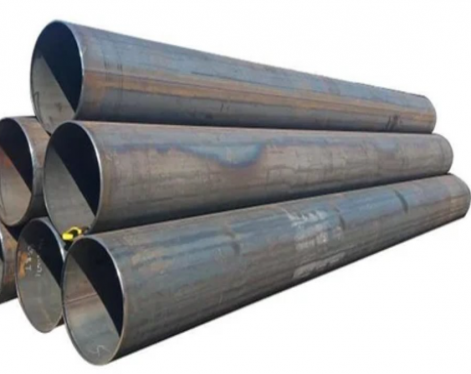The advanced nature of high frequency welded pipe:
The development history of welded tube technology has progressed with the competition of seamless steel pipe products. To replace seamless steel pipes with welded steel pipes in certain fields, the key lies in the high product quality and lower production costs. The output of high frequency straight seam welded pipe currently accounts for about 80% of the total output of welded pipe in my country, and it is the main type of welded pipe development in my country. Therefore, to ensure the high quality of high-frequency straight seam welded pipes, we mainly rely on three aspects of technology, one is the improvement of steel smelting technology, the other is the improvement of hot-rolled strip technology, and the third is the improvement of pipe-making technology.
Principles and characteristics of high frequency welded pipe welding:
The high frequency welding method was invented and used in production in the early 1950s. In high-frequency welding, the welding current flows only on the workpiece parallel to the interface of the street, which depends on the current frequency, the resistivity and permeability of the workpiece. As the frequency increases, the depth of current penetration decreases and the distribution becomes more concentrated. Because the current is concentrated in a very shallow and narrow area on the surface of the workpiece during high frequency welding, a much smaller current than ordinary resistance welding can be used to make the welding area reach the welding temperature, thereby greatly improving the welding speed and welding efficiency. To successfully perform high frequency welding, other factors must be considered, such as the type and thickness of metal materials.
Compared with other welding methods, high frequency welding has a series of advantages:
1. High welding speed
Since the current energy is highly concentrated in the welding area, the heating speed is extremely fast, and there is no skip welding phenomenon during high-speed welding, so the welding speed can be as high as 150 or even 200m/mim.
2. Small heat affected zone
Because of the high welding speed and strong self-cooling of the workpiece, not only the heat-affected zone is small, but also it is not easy to oxidize, so that a weld with good structure and performance can be obtained.
3. It is not necessary to remove the oxide film and dirt on the surface of the workpiece to be welded before welding. The oxide film and dirt on the surface of the hot-rolled base metal can be conducted by high-frequency current, thus eliminating the need for cleaning before welding. welding.
4. There are many types of metals that can be welded, and the products have many shapes and specifications. It can not only weld carbon steel and alloy steel, but also stainless steel and nickel-based alloys that are usually difficult to weld.
The development history of welded tube technology has progressed with the competition of seamless steel pipe products. To replace seamless steel pipes with welded steel pipes in certain fields, the key lies in the high product quality and lower production costs. The output of high frequency straight seam welded pipe currently accounts for about 80% of the total output of welded pipe in my country, and it is the main type of welded pipe development in my country. Therefore, to ensure the high quality of high-frequency straight seam welded pipes, we mainly rely on three aspects of technology, one is the improvement of steel smelting technology, the other is the improvement of hot-rolled strip technology, and the third is the improvement of pipe-making technology.
Principles and characteristics of high frequency welded pipe welding:
The high frequency welding method was invented and used in production in the early 1950s. In high-frequency welding, the welding current flows only on the workpiece parallel to the interface of the street, which depends on the current frequency, the resistivity and permeability of the workpiece. As the frequency increases, the depth of current penetration decreases and the distribution becomes more concentrated. Because the current is concentrated in a very shallow and narrow area on the surface of the workpiece during high frequency welding, a much smaller current than ordinary resistance welding can be used to make the welding area reach the welding temperature, thereby greatly improving the welding speed and welding efficiency. To successfully perform high frequency welding, other factors must be considered, such as the type and thickness of metal materials.
Compared with other welding methods, high frequency welding has a series of advantages:
1. High welding speed
Since the current energy is highly concentrated in the welding area, the heating speed is extremely fast, and there is no skip welding phenomenon during high-speed welding, so the welding speed can be as high as 150 or even 200m/mim.
2. Small heat affected zone
Because of the high welding speed and strong self-cooling of the workpiece, not only the heat-affected zone is small, but also it is not easy to oxidize, so that a weld with good structure and performance can be obtained.
3. It is not necessary to remove the oxide film and dirt on the surface of the workpiece to be welded before welding. The oxide film and dirt on the surface of the hot-rolled base metal can be conducted by high-frequency current, thus eliminating the need for cleaning before welding. welding.
4. There are many types of metals that can be welded, and the products have many shapes and specifications. It can not only weld carbon steel and alloy steel, but also stainless steel and nickel-based alloys that are usually difficult to weld.









